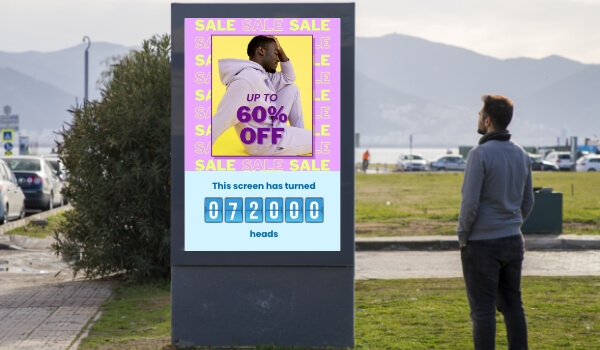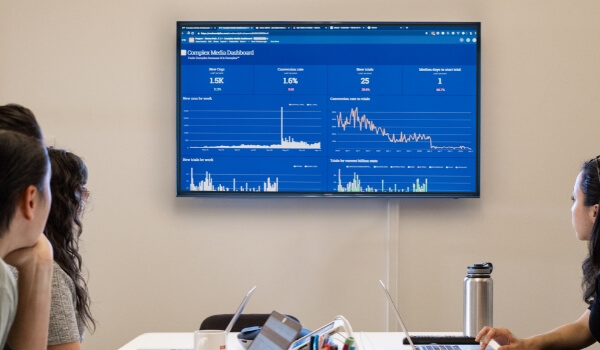
Nov 30 2022
9 min read


Oct
Autumn.
Driving down Broadway on a particularly chilly October morning, you swoosh past numerous billboards and posters, most of them digital screens displaying new products, events, or announcements. The colors and transitions, indeed, are a spectacle! But how do these help brands understand the way people interact with them?
Enter digital signage analytics― a vital weapon businesses use to help them make informed choices and personalize the content on digital signage based on parameters linked to demographics, immediate reactions, and time spent paying attention.
Nowadays, it is possible to be precise using analytics and understand your customer’s preferences while at the same time helping your brand stay relevant. Let’s delve deeper into what digital signage analytics truly means for your business.
Digital signage analytics are specific software-incorporated statistics used to determine the number of people who watch, interact, and are interested in what you offer. It helps understand customer engagement, so the right messages and calls to action get put in front of them.
Based on the information gathered, messages can be targeted and tweaked to be more effective and deliver better and more directly attributable ROI.
Alternatively, digital signage analytics might also refer to showing any analytics (such as insights on company performance, sales, or employee productivity metrics) on your team’s internal communications screen. This form of digital signage analytics helps to improve your internal communication and organizational efficiency.
But how do these two varied definitions of digital signage analytics help businesses make rational business decisions? What are the implications of each, and how important are these?
Let’s take a look.
When presented on a digital signage screen or even those produced by the software that empowers screens, market data can help businesses bring forth numerous operational changes.
For instance, brands can instantly identify what content or ads are effective with customers. This can go so far as to compare sales figures of specific products based on the times of the day and frequency of the ads for the individual item.

Digital signage software coupled with marketing analytics can enhance consumer experience depending on what kind of traffic is at your landing page right after. These provide businesses with information on the micro-level performance of their signage system.
Some examples can be:
Customers’ or visitors’ demographics, such as age, gender, and ethnicity, can be analyzed using facial recognition technology on check-in kiosks at museums, libraries, movie theatres, etc.
The dwell time, or the time a user interacts with a particular page on a digital screen, can give an idea of the average interests of the target audience.
Quantifiable activities like the number of QR scans, average wait time in queues, and viewer analytics (like counting the number of times people turn their heads to see the content on screen)
Digital signage analytics are the most relevant and reliable when tracking crowd activity, especially in museums, art galleries, movie theatres, airports, hospitals, shopping malls, etc.
Self-ticketing kiosks, one-to-one interactive check-ins, door sensors that detect footfall, etc., help your system keep track of the number of daily and monthly visitors you get in a day. It can also help assess your peak business hours and plan all significant events or happy hours around that time. You can also drop the most important announcements of the day at these popular times.

Market analytics displayed on your internal communication signage screen can be a great push for the team. Many digital signage software applications like Pickcel can be integrated with the organization’s internal dashboards to show various KPI metrics on screen.
For example, the monthly sales statistics show which idea worked the best, what consumers engaged with the most, and which areas can be improved. These insights, when displayed on your office digital signage, will make all your employees sit up and take notice. And, who knows? Maybe that graphics intern can get you a million-bucks idea!
Businesses can cut back on expenditure via digital signage analytics and a Content Management System (CMS) to show the most relevant material at any given time.
By displaying dynamic real-time material rather than printing ads every time you launch something new. Modifications can also be implemented with a minimum time lag to connect with your target audience better, increasing your return on investment (ROI).
Digital Signage analytics can be used to bring about several changes and set existing operating procedures right. These insights are essential for crafting the right set of signage measures to bring about strategic changes. Here are a few ways analytics can be used in digital signage.
Help analyze your audience’s behavioral pattern and tailor offers and announcements accordingly.
Metrics gathered from the point of sale (PoS) applications can help you identify gaps between the demand and supply, manage inventories, and get new retail workers quickly up to speed on goods and services, converting more sales.
Help allocate resources and deploy the workforce in the right places.
Audience analytics can help businesses keep track of consumers’ preferences. From time spent interacting with an outdoor sign to being tempted to make an actual purchase, the right message boosts sales.
Analytics can also help understand what kind of dynamic content on your signage screens engages your audience the most and more visually-effective and interactive messages.
We are living in an age of data. All your assets can gather some form of data and insights to help you make informed decisions. Digital signage analytics can form the basis of many of your consumer-facing initiatives.
Starting from what your audience prefers, their consumption patterns, and what customizations can be done to bring up new ideas from employees who contribute to implementing these changes, this forms an indispensable part of your business.
Instant communications require instant action, and with real time interactions shared right from your signage software, understanding that little advertising loophole is no longer a catch-22!
Take complete control of what you show on your digital signage & how you show it.
Start Free Trial Schedule My Demo
Nov 30 2022
9 min read

Nov 11 2022
8 min read

Sep 20 2022
12 min read

Sep 2 2022
8 min read